Comprehensive Investment Analysis of Unilever PLC: A Detailed Report
VerifiedAdded on 2023/01/06
|29
|4118
|94
Report
AI Summary
This report presents a detailed investment analysis of Unilever, a FTSE-listed consumer goods company. It encompasses an executive summary, investment summary, business description, industry overview, competitive positioning, and financial analysis. The report includes a valuation based on the Price to Earnings (PE) ratio and provides an investment recommendation. The financial analysis covers profitability, liquidity, and efficiency ratios, highlighting Unilever's performance over three years. The business description details the company's segments, product portfolio, business model, and revenue contributions. The industry overview examines market share in different nations, competitive strategies, and market positioning. The report also discusses investment risks and provides references. The analysis suggests a buy recommendation based on the PE ratio, despite concerns about potential inflation. The report is a student contribution to Desklib, providing insights into Unilever's financial health and investment prospects.
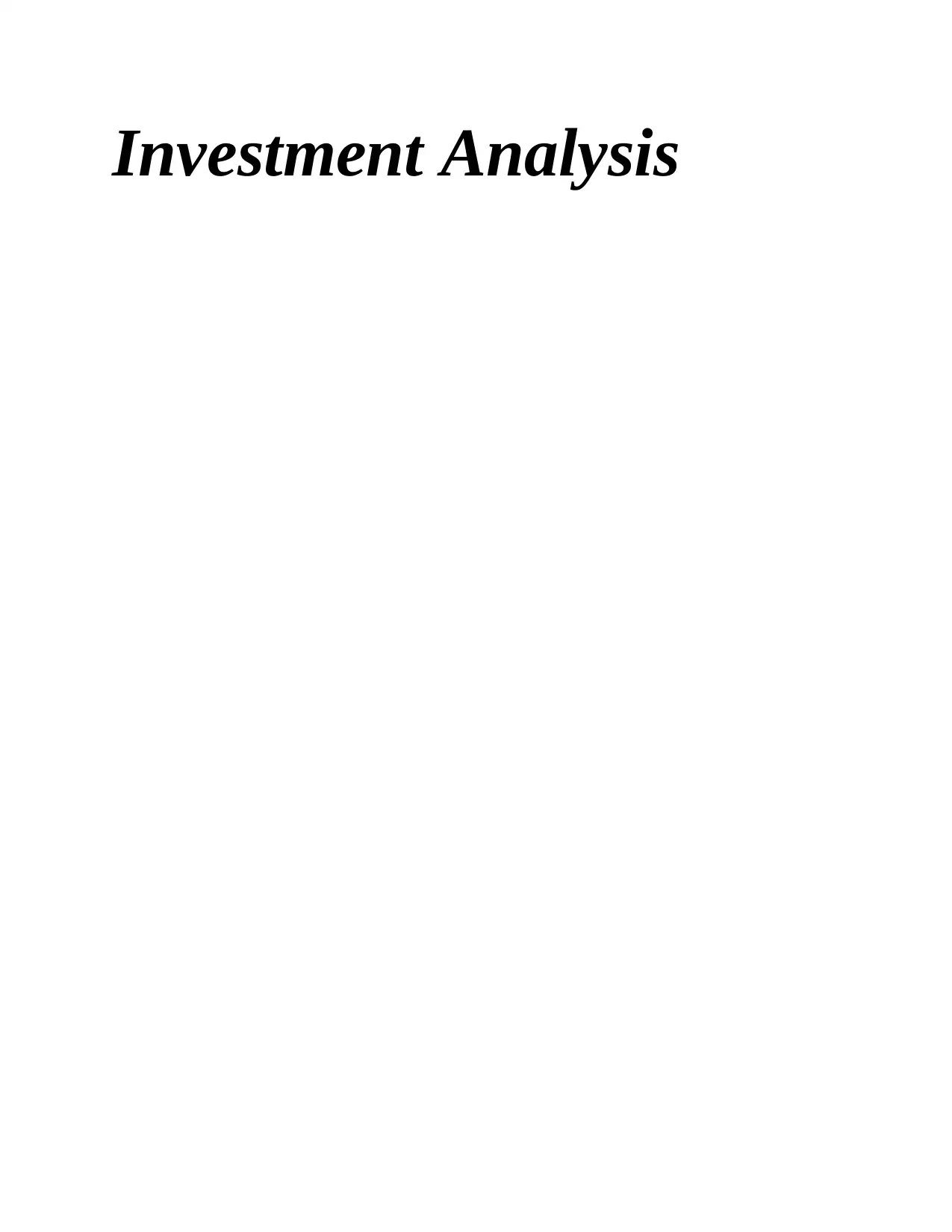
Investment Analysis
Paraphrase This Document
Need a fresh take? Get an instant paraphrase of this document with our AI Paraphraser
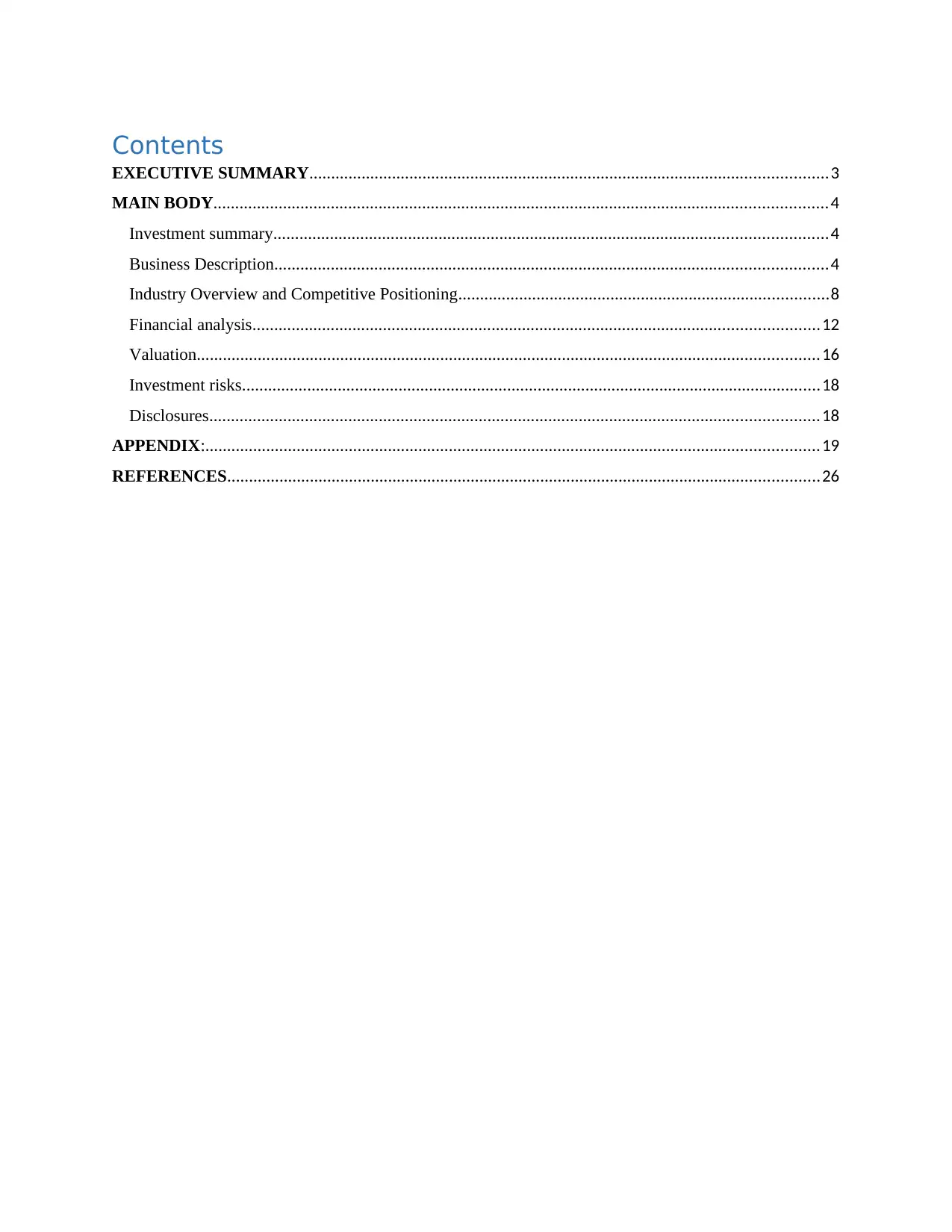
Contents
EXECUTIVE SUMMARY.......................................................................................................................3
MAIN BODY.............................................................................................................................................4
Investment summary...............................................................................................................................4
Business Description...............................................................................................................................4
Industry Overview and Competitive Positioning.....................................................................................8
Financial analysis..................................................................................................................................12
Valuation...............................................................................................................................................16
Investment risks.....................................................................................................................................18
Disclosures............................................................................................................................................18
APPENDIX:.............................................................................................................................................19
REFERENCES........................................................................................................................................26
EXECUTIVE SUMMARY.......................................................................................................................3
MAIN BODY.............................................................................................................................................4
Investment summary...............................................................................................................................4
Business Description...............................................................................................................................4
Industry Overview and Competitive Positioning.....................................................................................8
Financial analysis..................................................................................................................................12
Valuation...............................................................................................................................................16
Investment risks.....................................................................................................................................18
Disclosures............................................................................................................................................18
APPENDIX:.............................................................................................................................................19
REFERENCES........................................................................................................................................26
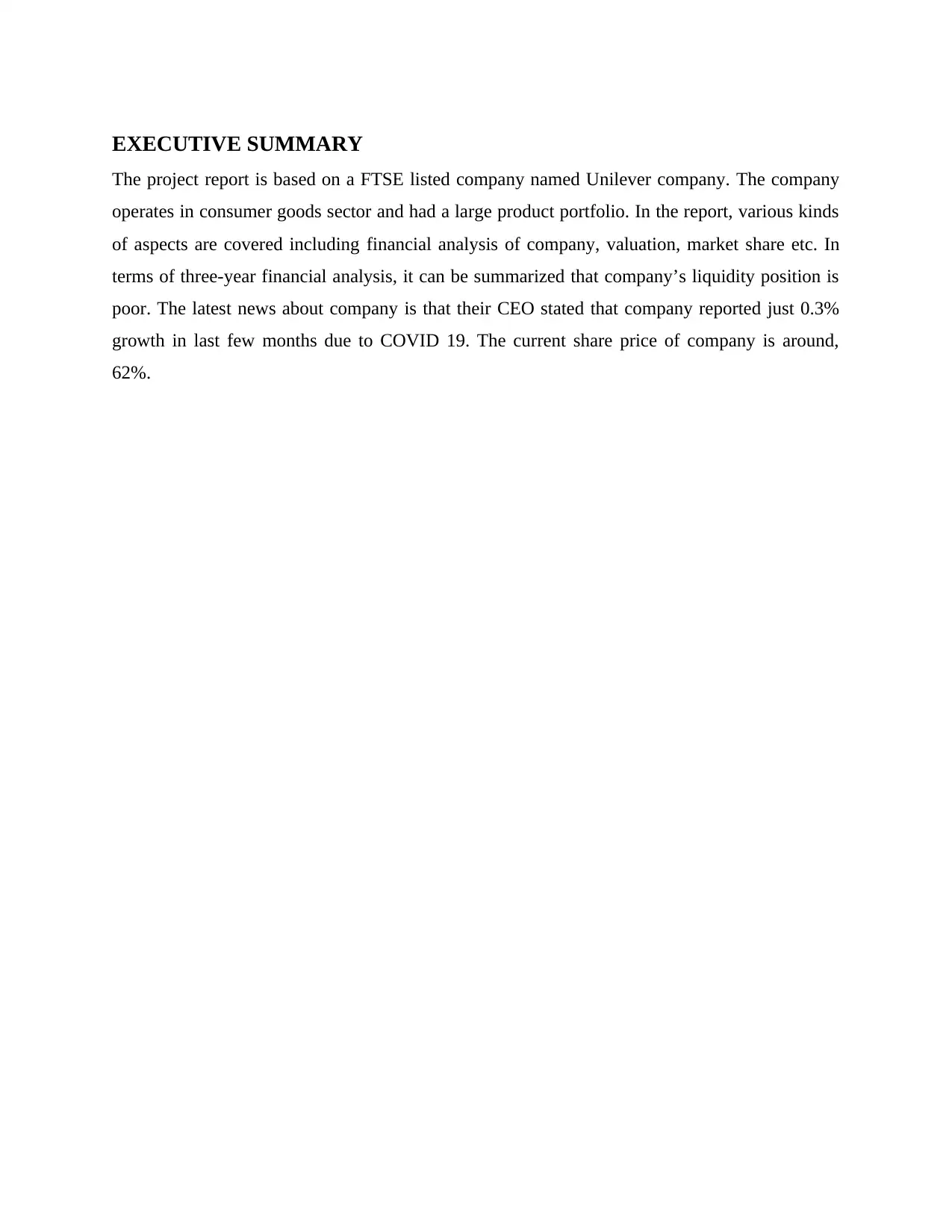
EXECUTIVE SUMMARY
The project report is based on a FTSE listed company named Unilever company. The company
operates in consumer goods sector and had a large product portfolio. In the report, various kinds
of aspects are covered including financial analysis of company, valuation, market share etc. In
terms of three-year financial analysis, it can be summarized that company’s liquidity position is
poor. The latest news about company is that their CEO stated that company reported just 0.3%
growth in last few months due to COVID 19. The current share price of company is around,
62%.
The project report is based on a FTSE listed company named Unilever company. The company
operates in consumer goods sector and had a large product portfolio. In the report, various kinds
of aspects are covered including financial analysis of company, valuation, market share etc. In
terms of three-year financial analysis, it can be summarized that company’s liquidity position is
poor. The latest news about company is that their CEO stated that company reported just 0.3%
growth in last few months due to COVID 19. The current share price of company is around,
62%.
⊘ This is a preview!⊘
Do you want full access?
Subscribe today to unlock all pages.

Trusted by 1+ million students worldwide
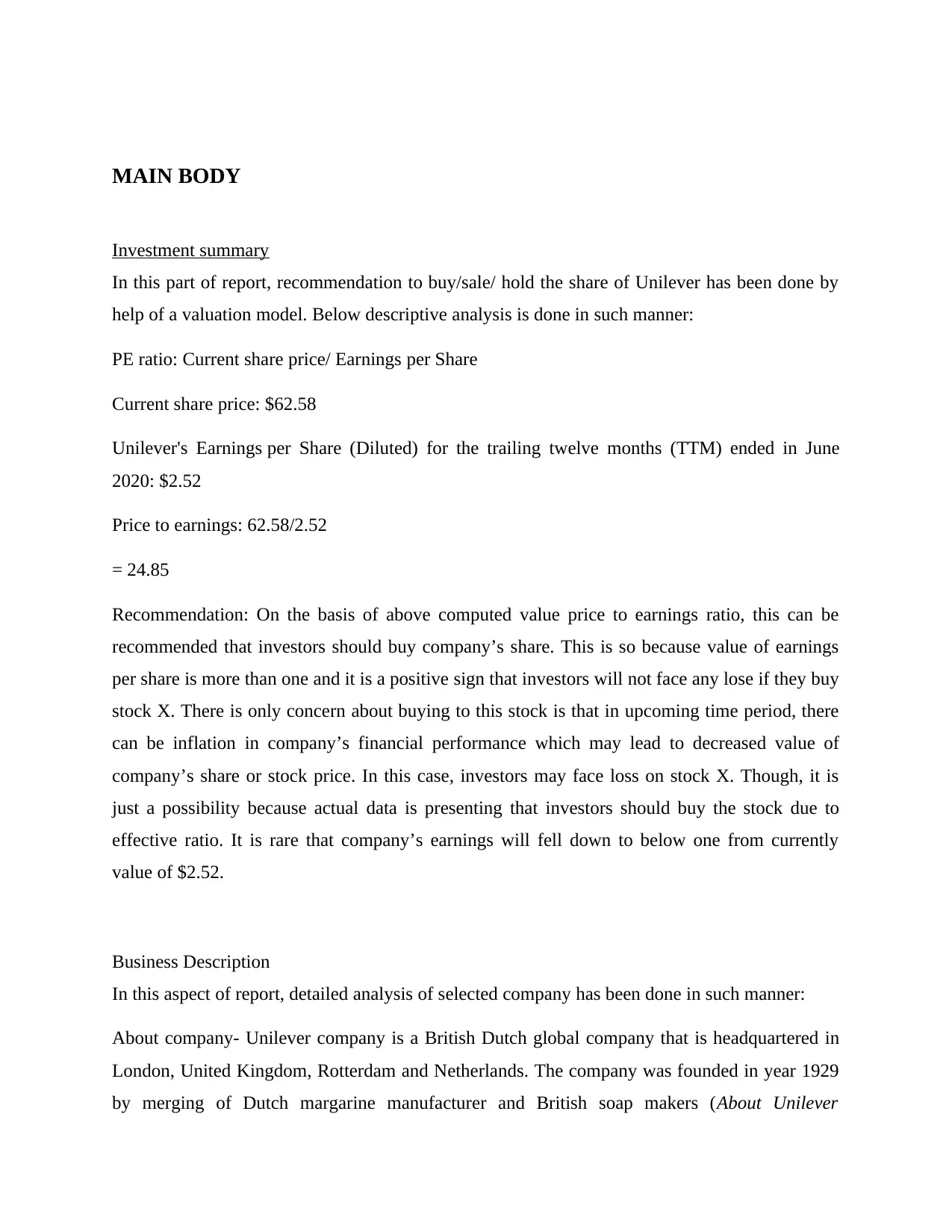
MAIN BODY
Investment summary
In this part of report, recommendation to buy/sale/ hold the share of Unilever has been done by
help of a valuation model. Below descriptive analysis is done in such manner:
PE ratio: Current share price/ Earnings per Share
Current share price: $62.58
Unilever's Earnings per Share (Diluted) for the trailing twelve months (TTM) ended in June
2020: $2.52
Price to earnings: 62.58/2.52
= 24.85
Recommendation: On the basis of above computed value price to earnings ratio, this can be
recommended that investors should buy company’s share. This is so because value of earnings
per share is more than one and it is a positive sign that investors will not face any lose if they buy
stock X. There is only concern about buying to this stock is that in upcoming time period, there
can be inflation in company’s financial performance which may lead to decreased value of
company’s share or stock price. In this case, investors may face loss on stock X. Though, it is
just a possibility because actual data is presenting that investors should buy the stock due to
effective ratio. It is rare that company’s earnings will fell down to below one from currently
value of $2.52.
Business Description
In this aspect of report, detailed analysis of selected company has been done in such manner:
About company- Unilever company is a British Dutch global company that is headquartered in
London, United Kingdom, Rotterdam and Netherlands. The company was founded in year 1929
by merging of Dutch margarine manufacturer and British soap makers (About Unilever
Investment summary
In this part of report, recommendation to buy/sale/ hold the share of Unilever has been done by
help of a valuation model. Below descriptive analysis is done in such manner:
PE ratio: Current share price/ Earnings per Share
Current share price: $62.58
Unilever's Earnings per Share (Diluted) for the trailing twelve months (TTM) ended in June
2020: $2.52
Price to earnings: 62.58/2.52
= 24.85
Recommendation: On the basis of above computed value price to earnings ratio, this can be
recommended that investors should buy company’s share. This is so because value of earnings
per share is more than one and it is a positive sign that investors will not face any lose if they buy
stock X. There is only concern about buying to this stock is that in upcoming time period, there
can be inflation in company’s financial performance which may lead to decreased value of
company’s share or stock price. In this case, investors may face loss on stock X. Though, it is
just a possibility because actual data is presenting that investors should buy the stock due to
effective ratio. It is rare that company’s earnings will fell down to below one from currently
value of $2.52.
Business Description
In this aspect of report, detailed analysis of selected company has been done in such manner:
About company- Unilever company is a British Dutch global company that is headquartered in
London, United Kingdom, Rotterdam and Netherlands. The company was founded in year 1929
by merging of Dutch margarine manufacturer and British soap makers (About Unilever
Paraphrase This Document
Need a fresh take? Get an instant paraphrase of this document with our AI Paraphraser
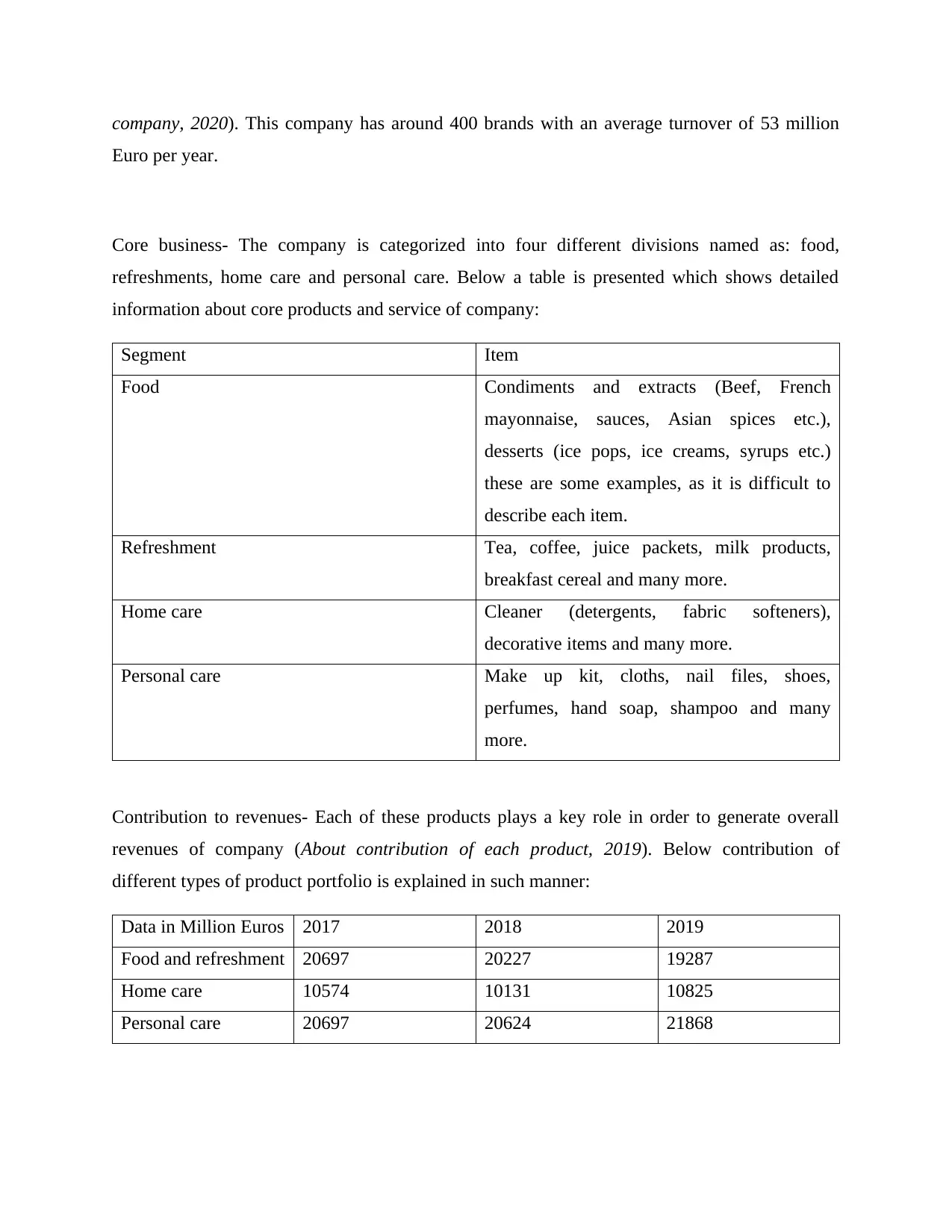
company, 2020). This company has around 400 brands with an average turnover of 53 million
Euro per year.
Core business- The company is categorized into four different divisions named as: food,
refreshments, home care and personal care. Below a table is presented which shows detailed
information about core products and service of company:
Segment Item
Food Condiments and extracts (Beef, French
mayonnaise, sauces, Asian spices etc.),
desserts (ice pops, ice creams, syrups etc.)
these are some examples, as it is difficult to
describe each item.
Refreshment Tea, coffee, juice packets, milk products,
breakfast cereal and many more.
Home care Cleaner (detergents, fabric softeners),
decorative items and many more.
Personal care Make up kit, cloths, nail files, shoes,
perfumes, hand soap, shampoo and many
more.
Contribution to revenues- Each of these products plays a key role in order to generate overall
revenues of company (About contribution of each product, 2019). Below contribution of
different types of product portfolio is explained in such manner:
Data in Million Euros 2017 2018 2019
Food and refreshment 20697 20227 19287
Home care 10574 10131 10825
Personal care 20697 20624 21868
Euro per year.
Core business- The company is categorized into four different divisions named as: food,
refreshments, home care and personal care. Below a table is presented which shows detailed
information about core products and service of company:
Segment Item
Food Condiments and extracts (Beef, French
mayonnaise, sauces, Asian spices etc.),
desserts (ice pops, ice creams, syrups etc.)
these are some examples, as it is difficult to
describe each item.
Refreshment Tea, coffee, juice packets, milk products,
breakfast cereal and many more.
Home care Cleaner (detergents, fabric softeners),
decorative items and many more.
Personal care Make up kit, cloths, nail files, shoes,
perfumes, hand soap, shampoo and many
more.
Contribution to revenues- Each of these products plays a key role in order to generate overall
revenues of company (About contribution of each product, 2019). Below contribution of
different types of product portfolio is explained in such manner:
Data in Million Euros 2017 2018 2019
Food and refreshment 20697 20227 19287
Home care 10574 10131 10825
Personal care 20697 20624 21868
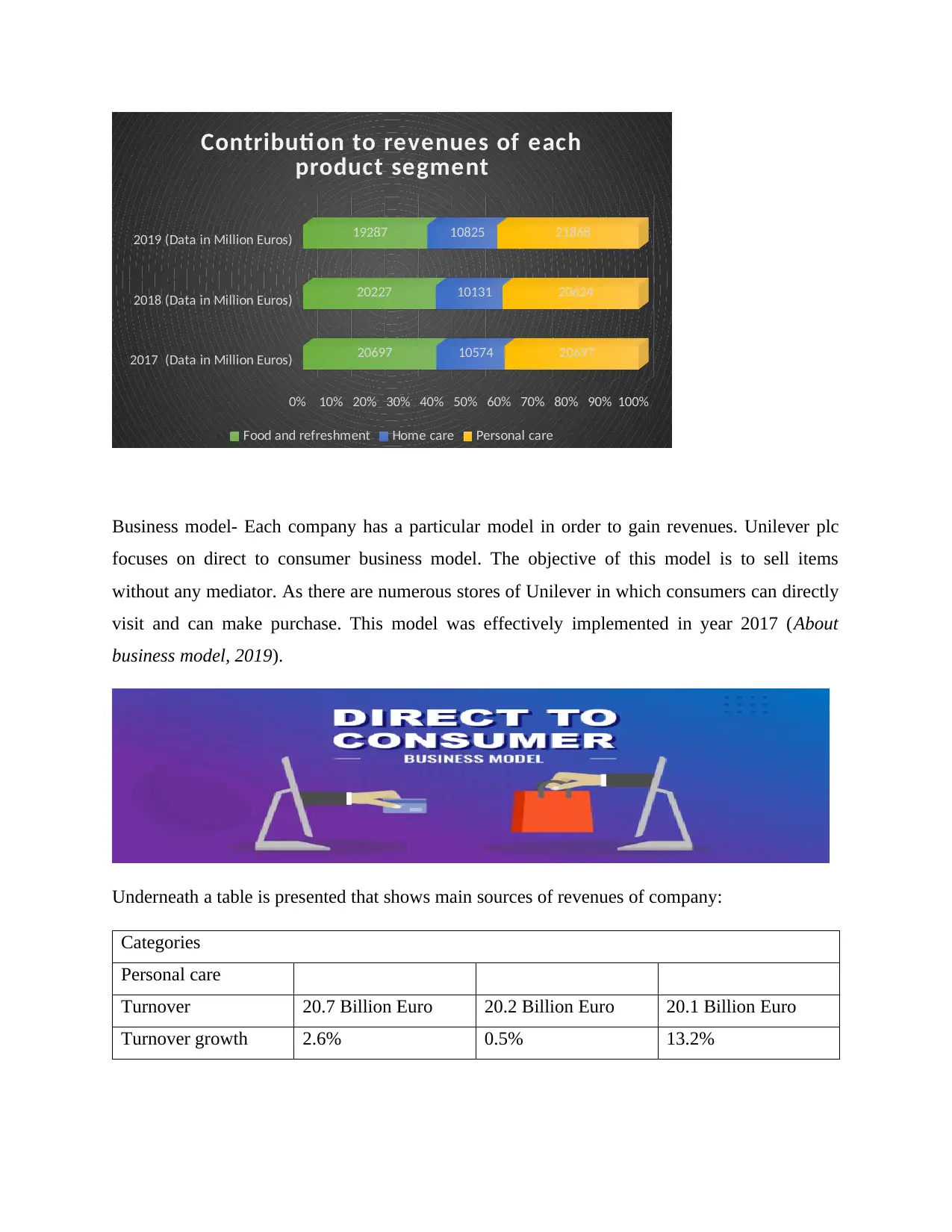
2017 (Data in Million Euros)
2018 (Data in Million Euros)
2019 (Data in Million Euros)
0% 10% 20% 30% 40% 50% 60% 70% 80% 90% 100%
20697
20227
19287
10574
10131
10825
20697
20624
21868
Contributi on to revenues of each
product segment
Food and refreshment Home care Personal care
Business model- Each company has a particular model in order to gain revenues. Unilever plc
focuses on direct to consumer business model. The objective of this model is to sell items
without any mediator. As there are numerous stores of Unilever in which consumers can directly
visit and can make purchase. This model was effectively implemented in year 2017 (About
business model, 2019).
Underneath a table is presented that shows main sources of revenues of company:
Categories
Personal care
Turnover 20.7 Billion Euro 20.2 Billion Euro 20.1 Billion Euro
Turnover growth 2.6% 0.5% 13.2%
2018 (Data in Million Euros)
2019 (Data in Million Euros)
0% 10% 20% 30% 40% 50% 60% 70% 80% 90% 100%
20697
20227
19287
10574
10131
10825
20697
20624
21868
Contributi on to revenues of each
product segment
Food and refreshment Home care Personal care
Business model- Each company has a particular model in order to gain revenues. Unilever plc
focuses on direct to consumer business model. The objective of this model is to sell items
without any mediator. As there are numerous stores of Unilever in which consumers can directly
visit and can make purchase. This model was effectively implemented in year 2017 (About
business model, 2019).
Underneath a table is presented that shows main sources of revenues of company:
Categories
Personal care
Turnover 20.7 Billion Euro 20.2 Billion Euro 20.1 Billion Euro
Turnover growth 2.6% 0.5% 13.2%
⊘ This is a preview!⊘
Do you want full access?
Subscribe today to unlock all pages.

Trusted by 1+ million students worldwide
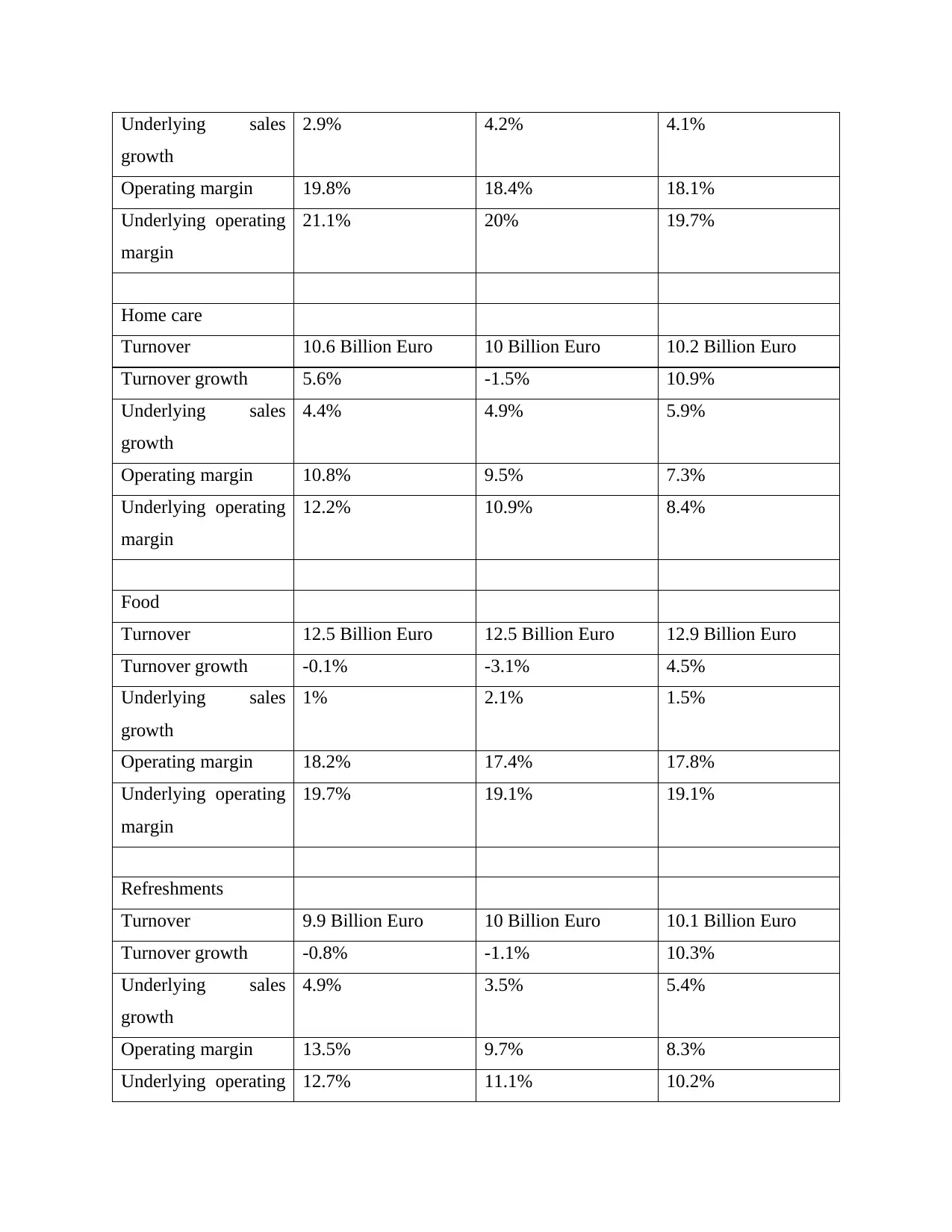
Underlying sales
growth
2.9% 4.2% 4.1%
Operating margin 19.8% 18.4% 18.1%
Underlying operating
margin
21.1% 20% 19.7%
Home care
Turnover 10.6 Billion Euro 10 Billion Euro 10.2 Billion Euro
Turnover growth 5.6% -1.5% 10.9%
Underlying sales
growth
4.4% 4.9% 5.9%
Operating margin 10.8% 9.5% 7.3%
Underlying operating
margin
12.2% 10.9% 8.4%
Food
Turnover 12.5 Billion Euro 12.5 Billion Euro 12.9 Billion Euro
Turnover growth -0.1% -3.1% 4.5%
Underlying sales
growth
1% 2.1% 1.5%
Operating margin 18.2% 17.4% 17.8%
Underlying operating
margin
19.7% 19.1% 19.1%
Refreshments
Turnover 9.9 Billion Euro 10 Billion Euro 10.1 Billion Euro
Turnover growth -0.8% -1.1% 10.3%
Underlying sales
growth
4.9% 3.5% 5.4%
Operating margin 13.5% 9.7% 8.3%
Underlying operating 12.7% 11.1% 10.2%
growth
2.9% 4.2% 4.1%
Operating margin 19.8% 18.4% 18.1%
Underlying operating
margin
21.1% 20% 19.7%
Home care
Turnover 10.6 Billion Euro 10 Billion Euro 10.2 Billion Euro
Turnover growth 5.6% -1.5% 10.9%
Underlying sales
growth
4.4% 4.9% 5.9%
Operating margin 10.8% 9.5% 7.3%
Underlying operating
margin
12.2% 10.9% 8.4%
Food
Turnover 12.5 Billion Euro 12.5 Billion Euro 12.9 Billion Euro
Turnover growth -0.1% -3.1% 4.5%
Underlying sales
growth
1% 2.1% 1.5%
Operating margin 18.2% 17.4% 17.8%
Underlying operating
margin
19.7% 19.1% 19.1%
Refreshments
Turnover 9.9 Billion Euro 10 Billion Euro 10.1 Billion Euro
Turnover growth -0.8% -1.1% 10.3%
Underlying sales
growth
4.9% 3.5% 5.4%
Operating margin 13.5% 9.7% 8.3%
Underlying operating 12.7% 11.1% 10.2%
Paraphrase This Document
Need a fresh take? Get an instant paraphrase of this document with our AI Paraphraser
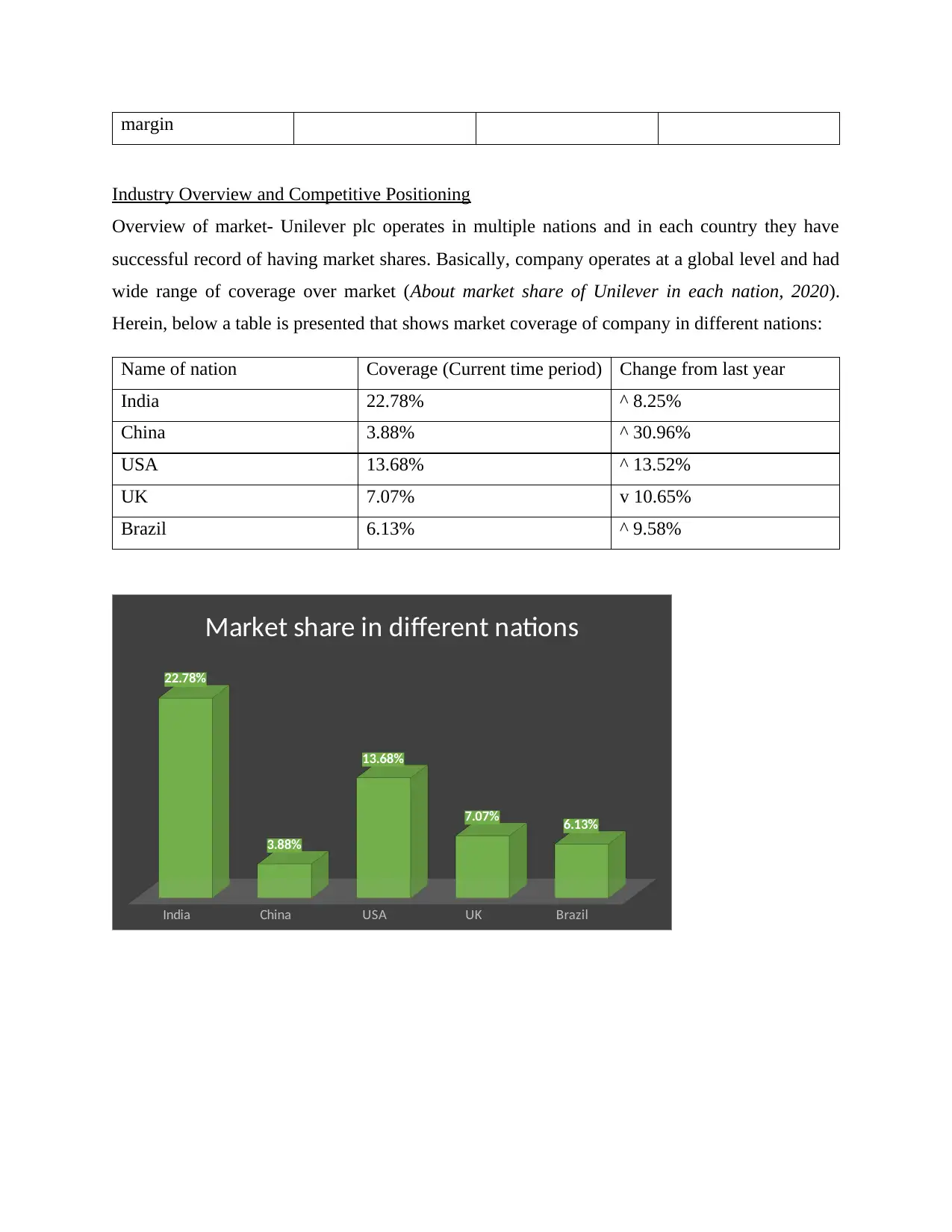
margin
Industry Overview and Competitive Positioning
Overview of market- Unilever plc operates in multiple nations and in each country they have
successful record of having market shares. Basically, company operates at a global level and had
wide range of coverage over market (About market share of Unilever in each nation, 2020).
Herein, below a table is presented that shows market coverage of company in different nations:
Name of nation Coverage (Current time period) Change from last year
India 22.78% ^ 8.25%
China 3.88% ^ 30.96%
USA 13.68% ^ 13.52%
UK 7.07% v 10.65%
Brazil 6.13% ^ 9.58%
India China USA UK Brazil
22.78%
3.88%
13.68%
7.07% 6.13%
Market share in different nations
Industry Overview and Competitive Positioning
Overview of market- Unilever plc operates in multiple nations and in each country they have
successful record of having market shares. Basically, company operates at a global level and had
wide range of coverage over market (About market share of Unilever in each nation, 2020).
Herein, below a table is presented that shows market coverage of company in different nations:
Name of nation Coverage (Current time period) Change from last year
India 22.78% ^ 8.25%
China 3.88% ^ 30.96%
USA 13.68% ^ 13.52%
UK 7.07% v 10.65%
Brazil 6.13% ^ 9.58%
India China USA UK Brazil
22.78%
3.88%
13.68%
7.07% 6.13%
Market share in different nations
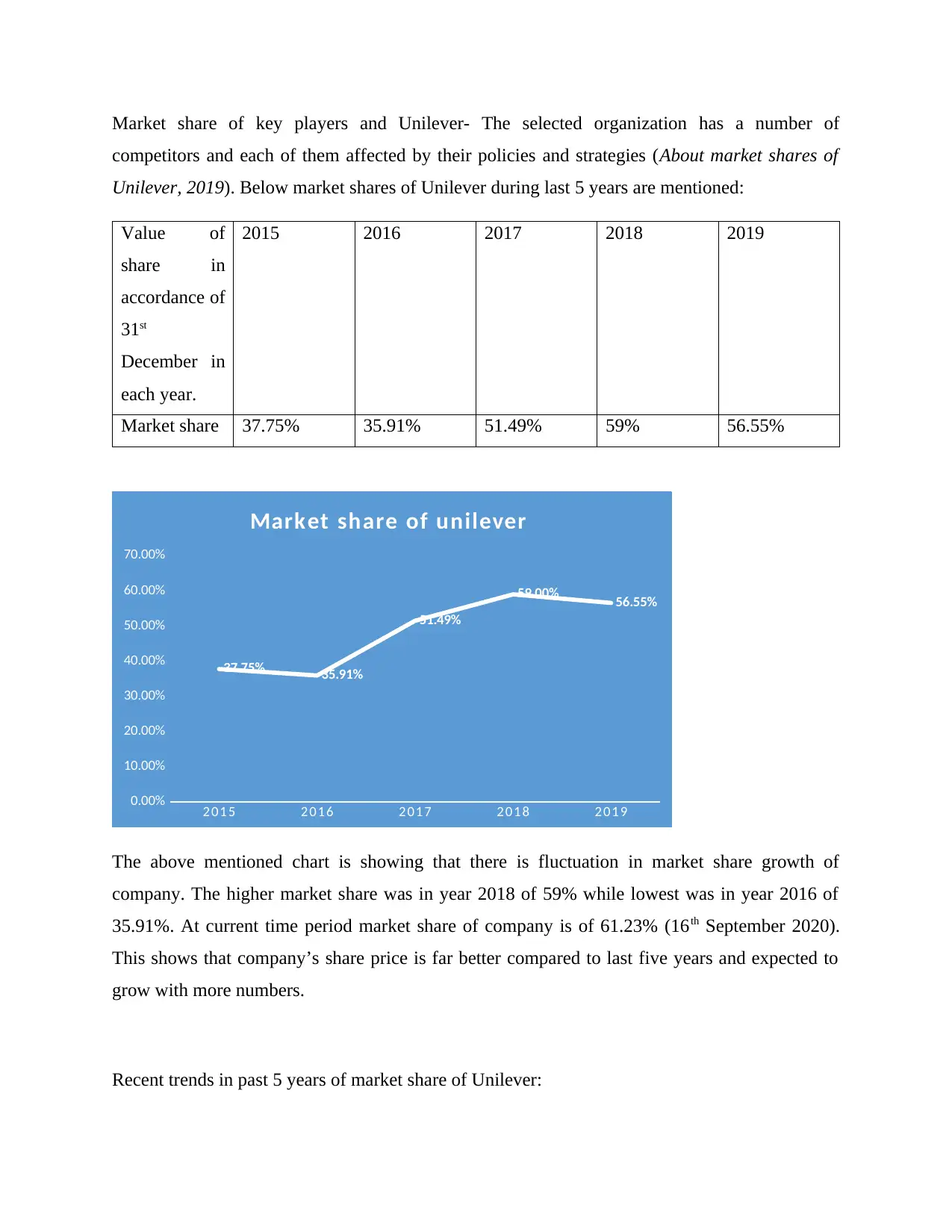
Market share of key players and Unilever- The selected organization has a number of
competitors and each of them affected by their policies and strategies (About market shares of
Unilever, 2019). Below market shares of Unilever during last 5 years are mentioned:
Value of
share in
accordance of
31st
December in
each year.
2015 2016 2017 2018 2019
Market share 37.75% 35.91% 51.49% 59% 56.55%
2 01 5 2 01 6 2 01 7 2 01 8 2 01 9
0.00%
10.00%
20.00%
30.00%
40.00%
50.00%
60.00%
70.00%
37.75% 35.91%
51.49%
59.00% 56.55%
Market share of unilever
The above mentioned chart is showing that there is fluctuation in market share growth of
company. The higher market share was in year 2018 of 59% while lowest was in year 2016 of
35.91%. At current time period market share of company is of 61.23% (16th September 2020).
This shows that company’s share price is far better compared to last five years and expected to
grow with more numbers.
Recent trends in past 5 years of market share of Unilever:
competitors and each of them affected by their policies and strategies (About market shares of
Unilever, 2019). Below market shares of Unilever during last 5 years are mentioned:
Value of
share in
accordance of
31st
December in
each year.
2015 2016 2017 2018 2019
Market share 37.75% 35.91% 51.49% 59% 56.55%
2 01 5 2 01 6 2 01 7 2 01 8 2 01 9
0.00%
10.00%
20.00%
30.00%
40.00%
50.00%
60.00%
70.00%
37.75% 35.91%
51.49%
59.00% 56.55%
Market share of unilever
The above mentioned chart is showing that there is fluctuation in market share growth of
company. The higher market share was in year 2018 of 59% while lowest was in year 2016 of
35.91%. At current time period market share of company is of 61.23% (16th September 2020).
This shows that company’s share price is far better compared to last five years and expected to
grow with more numbers.
Recent trends in past 5 years of market share of Unilever:
⊘ This is a preview!⊘
Do you want full access?
Subscribe today to unlock all pages.

Trusted by 1+ million students worldwide
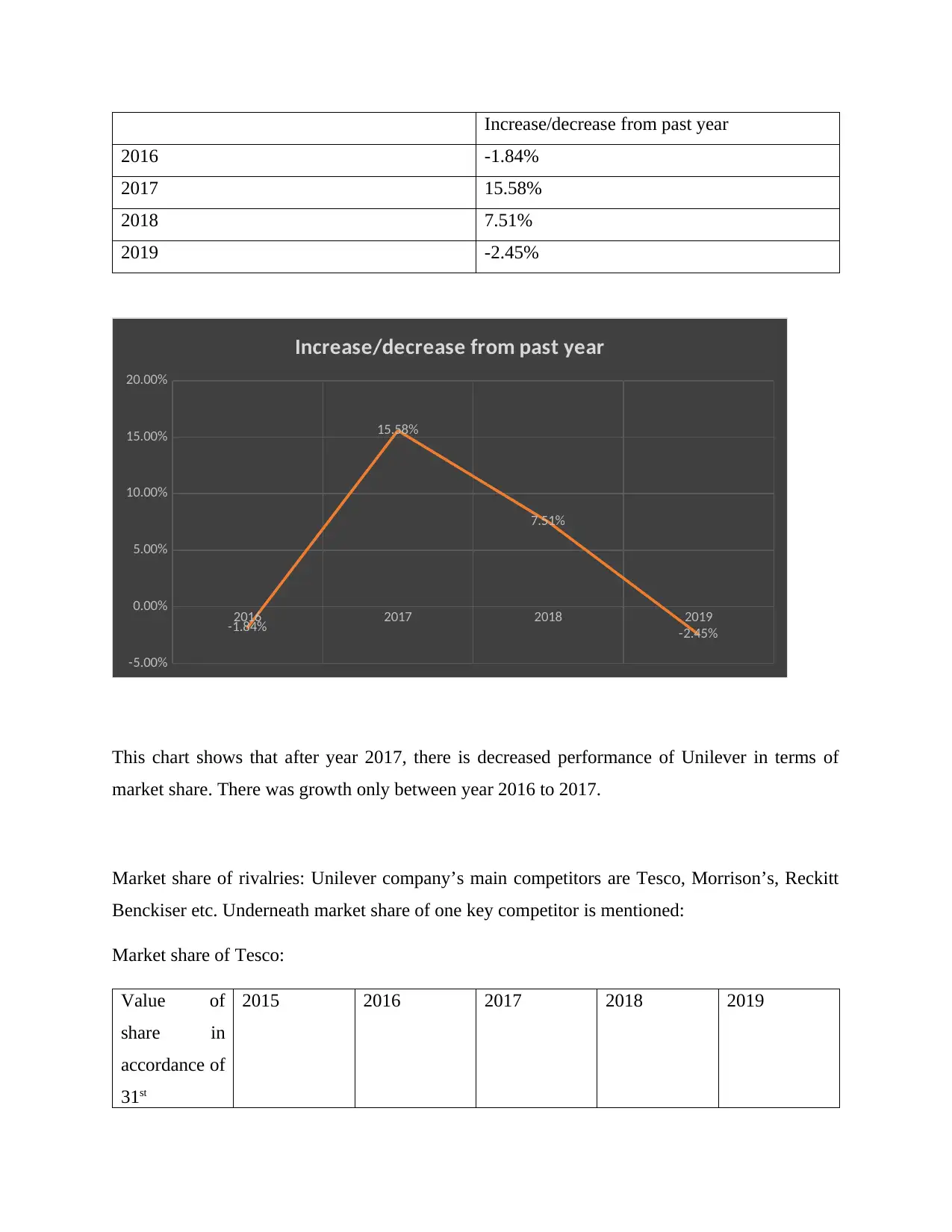
Increase/decrease from past year
2016 -1.84%
2017 15.58%
2018 7.51%
2019 -2.45%
2016 2017 2018 2019
-5.00%
0.00%
5.00%
10.00%
15.00%
20.00%
-1.84%
15.58%
7.51%
-2.45%
Increase/decrease from past year
This chart shows that after year 2017, there is decreased performance of Unilever in terms of
market share. There was growth only between year 2016 to 2017.
Market share of rivalries: Unilever company’s main competitors are Tesco, Morrison’s, Reckitt
Benckiser etc. Underneath market share of one key competitor is mentioned:
Market share of Tesco:
Value of
share in
accordance of
31st
2015 2016 2017 2018 2019
2016 -1.84%
2017 15.58%
2018 7.51%
2019 -2.45%
2016 2017 2018 2019
-5.00%
0.00%
5.00%
10.00%
15.00%
20.00%
-1.84%
15.58%
7.51%
-2.45%
Increase/decrease from past year
This chart shows that after year 2017, there is decreased performance of Unilever in terms of
market share. There was growth only between year 2016 to 2017.
Market share of rivalries: Unilever company’s main competitors are Tesco, Morrison’s, Reckitt
Benckiser etc. Underneath market share of one key competitor is mentioned:
Market share of Tesco:
Value of
share in
accordance of
31st
2015 2016 2017 2018 2019
Paraphrase This Document
Need a fresh take? Get an instant paraphrase of this document with our AI Paraphraser
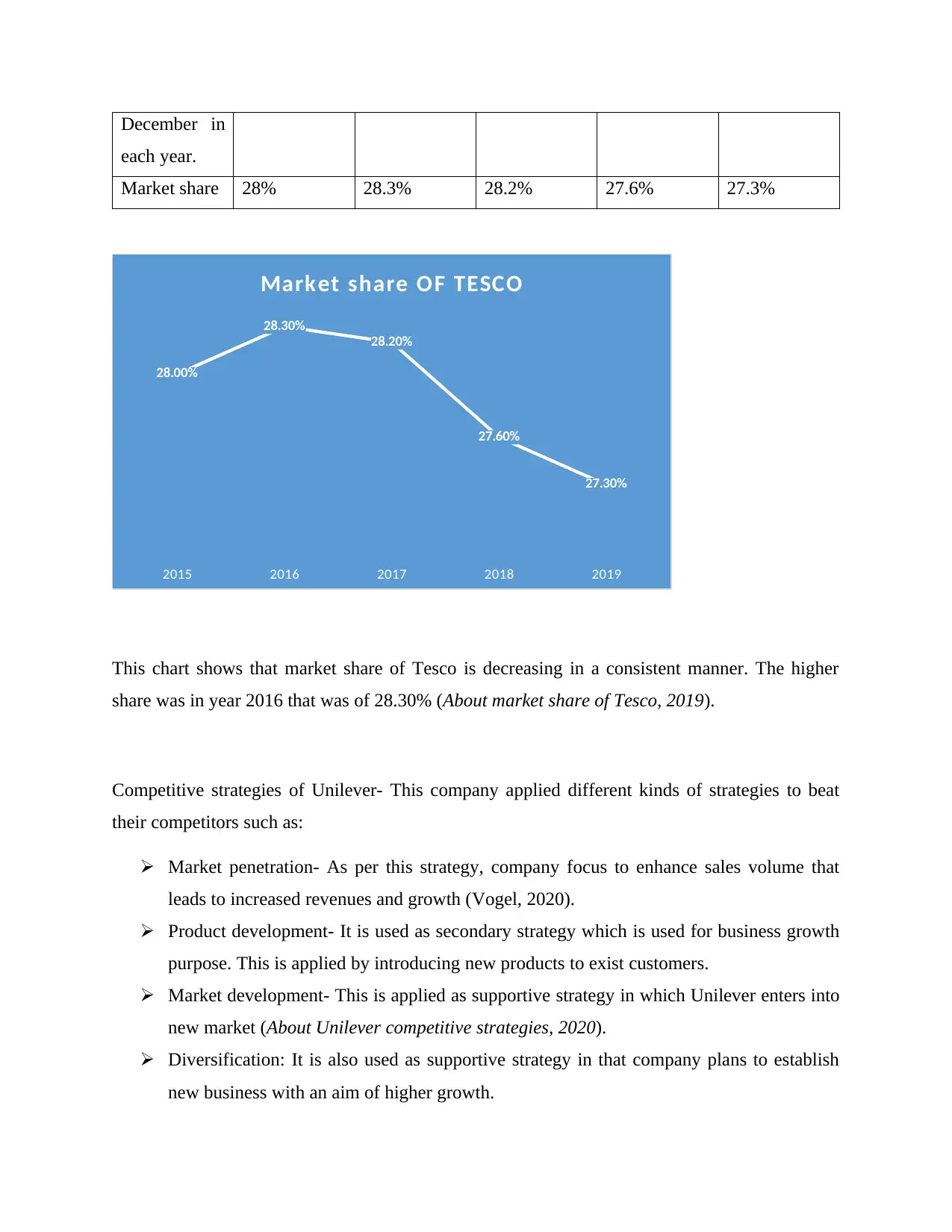
December in
each year.
Market share 28% 28.3% 28.2% 27.6% 27.3%
2015 2016 2017 2018 2019
28.00%
28.30%
28.20%
27.60%
27.30%
Market share OF TESCO
This chart shows that market share of Tesco is decreasing in a consistent manner. The higher
share was in year 2016 that was of 28.30% (About market share of Tesco, 2019).
Competitive strategies of Unilever- This company applied different kinds of strategies to beat
their competitors such as:
Market penetration- As per this strategy, company focus to enhance sales volume that
leads to increased revenues and growth (Vogel, 2020).
Product development- It is used as secondary strategy which is used for business growth
purpose. This is applied by introducing new products to exist customers.
Market development- This is applied as supportive strategy in which Unilever enters into
new market (About Unilever competitive strategies, 2020).
Diversification: It is also used as supportive strategy in that company plans to establish
new business with an aim of higher growth.
each year.
Market share 28% 28.3% 28.2% 27.6% 27.3%
2015 2016 2017 2018 2019
28.00%
28.30%
28.20%
27.60%
27.30%
Market share OF TESCO
This chart shows that market share of Tesco is decreasing in a consistent manner. The higher
share was in year 2016 that was of 28.30% (About market share of Tesco, 2019).
Competitive strategies of Unilever- This company applied different kinds of strategies to beat
their competitors such as:
Market penetration- As per this strategy, company focus to enhance sales volume that
leads to increased revenues and growth (Vogel, 2020).
Product development- It is used as secondary strategy which is used for business growth
purpose. This is applied by introducing new products to exist customers.
Market development- This is applied as supportive strategy in which Unilever enters into
new market (About Unilever competitive strategies, 2020).
Diversification: It is also used as supportive strategy in that company plans to establish
new business with an aim of higher growth.
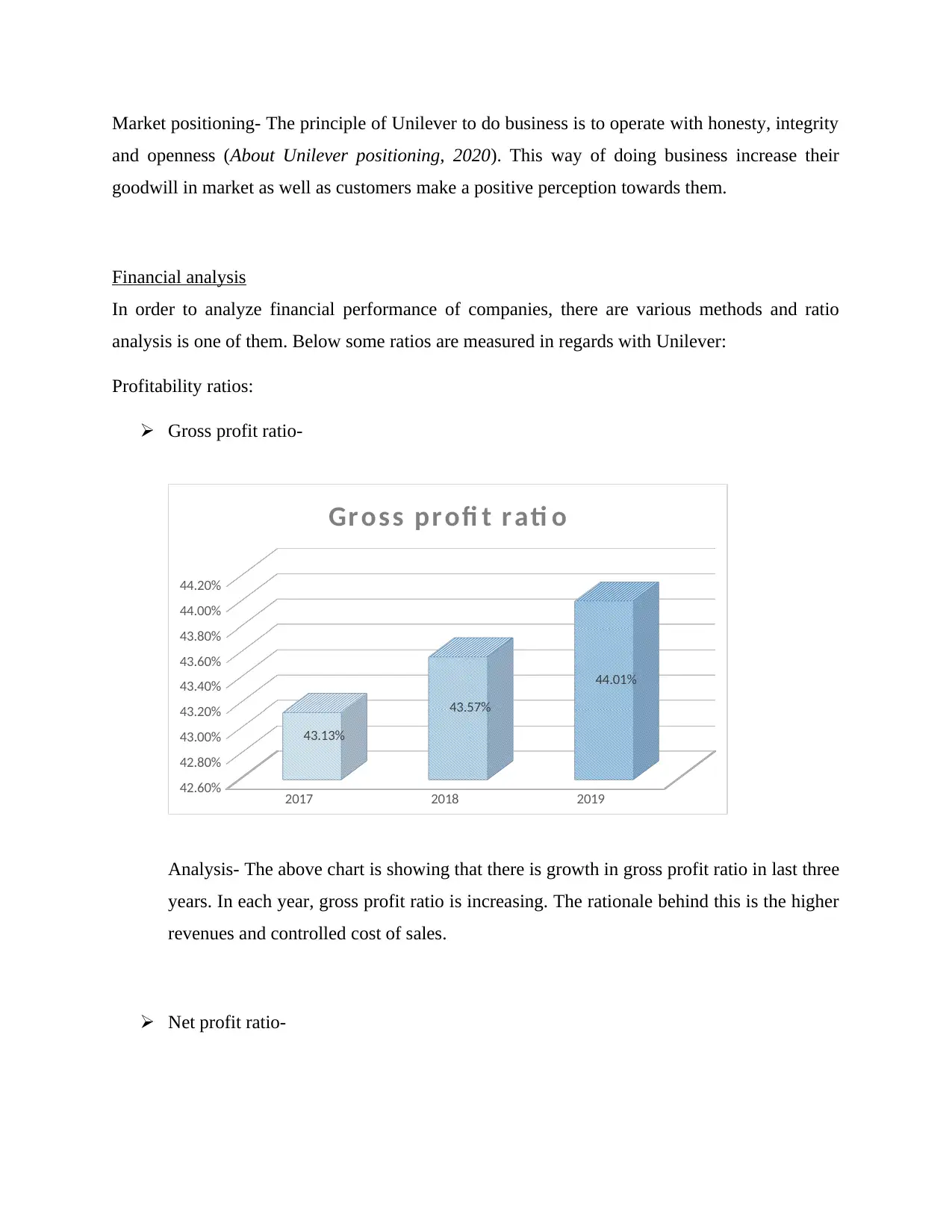
Market positioning- The principle of Unilever to do business is to operate with honesty, integrity
and openness (About Unilever positioning, 2020). This way of doing business increase their
goodwill in market as well as customers make a positive perception towards them.
Financial analysis
In order to analyze financial performance of companies, there are various methods and ratio
analysis is one of them. Below some ratios are measured in regards with Unilever:
Profitability ratios:
Gross profit ratio-
2017 2018 2019
42.60%
42.80%
43.00%
43.20%
43.40%
43.60%
43.80%
44.00%
44.20%
43.13%
43.57%
44.01%
Gross profi t r ati o
Analysis- The above chart is showing that there is growth in gross profit ratio in last three
years. In each year, gross profit ratio is increasing. The rationale behind this is the higher
revenues and controlled cost of sales.
Net profit ratio-
and openness (About Unilever positioning, 2020). This way of doing business increase their
goodwill in market as well as customers make a positive perception towards them.
Financial analysis
In order to analyze financial performance of companies, there are various methods and ratio
analysis is one of them. Below some ratios are measured in regards with Unilever:
Profitability ratios:
Gross profit ratio-
2017 2018 2019
42.60%
42.80%
43.00%
43.20%
43.40%
43.60%
43.80%
44.00%
44.20%
43.13%
43.57%
44.01%
Gross profi t r ati o
Analysis- The above chart is showing that there is growth in gross profit ratio in last three
years. In each year, gross profit ratio is increasing. The rationale behind this is the higher
revenues and controlled cost of sales.
Net profit ratio-
⊘ This is a preview!⊘
Do you want full access?
Subscribe today to unlock all pages.

Trusted by 1+ million students worldwide
1 out of 29
Related Documents
Your All-in-One AI-Powered Toolkit for Academic Success.
+13062052269
info@desklib.com
Available 24*7 on WhatsApp / Email
![[object Object]](/_next/static/media/star-bottom.7253800d.svg)
Unlock your academic potential
Copyright © 2020–2025 A2Z Services. All Rights Reserved. Developed and managed by ZUCOL.





